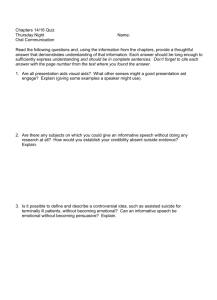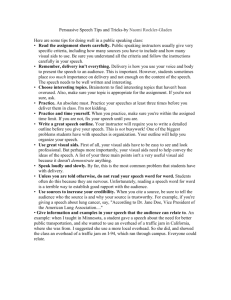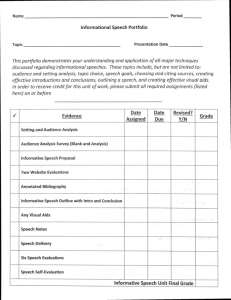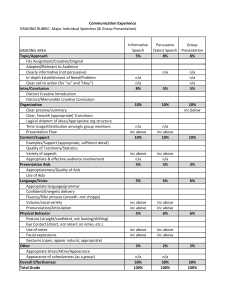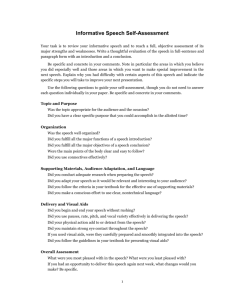Powerpoint - GEOCITIES.ws
advertisement
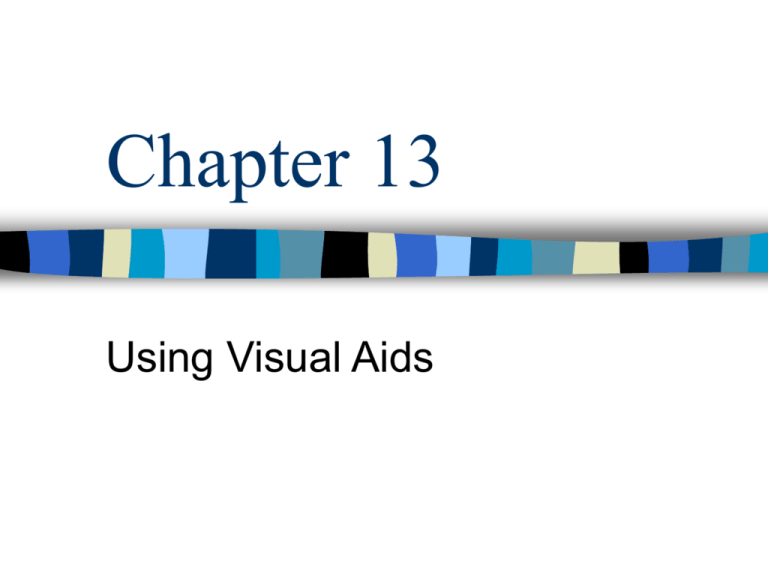
Chapter 13 Using Visual Aids To Do List: Discuss Details of Informative Speech Review Schedule – 13/14 Today, Wednesday Workshop, Friday Speeches Start – When will we get the exam grades back? 3 Advantages of Visual Aids Clarity – clarify discussion of an idea by showing a picture or representation of it – Again, Perot charts Interest – visual aids effectively generate interest – Picture books, text books? Retention – visual images often are remembered longer than verbal ones – Examples? Total bowls… others? Different Kinds of Visual Aids Ultimate visual aid would be the object of the speech itself UConn Fine Arts Building proposals? Or you can use: – – – – – – – – Models – built to scale (smaller/larger) Photographs – only used enlarged Drawings – diagrams, sketches, or maps Graphs – for statistical trends (bar, line, pie) Slides and Videotapes – vivid presentation Computer-Generated Graphics Transparencies Multimedia Presentations – Powerpoint 6 Guidelines for preparing visual aids Prepare visual aids in advance – Time for creativity – Can then be used during practice Keep visual aids simple – Ultimate goal is communication not art – Limit to manageable amount of information Make sure visual aids are large enough – Useless if they can’t be seen – “I know some of you can’t see this, but…” Guidelines for preparing visual aids Use fonts that are easy to read – Font – a complete set of type of the same design – Avoid decorative fonts – Use Arial, Times New Roman or Courier New Use a limited number of fonts – Book says no more than two per slide – Styles (bold, italic, underlined) can be used, but it is preferred not to use more than two font faces Guidelines for preparing visual aids Use color effectively – “When used effectively, it increases recognition by 78% and comprehension by 73%” (p. 329) – Color should only be varied for functional purposes • Highlighting • Distinguishing • Etc. Tips for Presenting Visual Aids Avoid using the chalkboard – Takes time – Does not look as neat and professional Display visual aids where listeners can see them – Examine classroom prior to speech to determine best location – Don’t stand in front of them Tips for Presenting Visual Aids Avoid passing visual aids among the audience – The IS distracting – Handouts generally compete with the speech for audience attention Display visual aids only while discussing them – Stats: Multiple Regression; Orwell Tips for Presenting Visual Aids Talk to your audience, not to your visual aid – Feedback – Always face your audience when talking Explain visual aids clearly and concisely – Most aids should be translated for the audience – Describe the aid to the audience, not just “as you can see” example Practice with your visual aids Chapter 14 Speaking to Inform The Informative Speech A speech designed to convey knowledge and understanding Judgment by peers will result from three general criteria: – Is the information communicated accurately? – Is the information communicated clearly? – Is the information made meaningful and interesting to the audience? 4 Types of Informative Speeches Speeches about Objects – Anything that is visible, tangible and stable in form – Specific Purpose example: To inform my audience about the social functions of comic strips Speeches about Processes – A systematic series of actions that leads to a specific result or product – Specific Purpose example: To inform my audience how to create their own Web pages 4 Types of Informative Speeches Speeches about Events – Anything that happens or is regarded as happening – Specific Purpose example: To inform my audience about what happened at the Battle of Little Big Horn Speeches about Concepts – A belief, theory, idea, notion, principle, or the like – Specific Purpose example: To inform my audience about the doctrine of original intent in constitutional interpretation Guidelines for Informative Speaking Don’t overestimate what the audience knows – How to make a PB & J sandwich Relate the subject directly to the audience – A speech is measured by its impact on a particular audience – Bush’s UN speech: Is the UN useful? Guidelines for Informative Speaking Don’t be too technical – Avoid Jargon • The specialized or technical language of a trade, profession, or similar group Avoid Abstractions – Three options: • Description • Comparison • Contrast Personalize your ideas – To present one’s ideas in human terms that relate in some fashion to the experience of the audience http://www.rube-goldberg.com Go back

